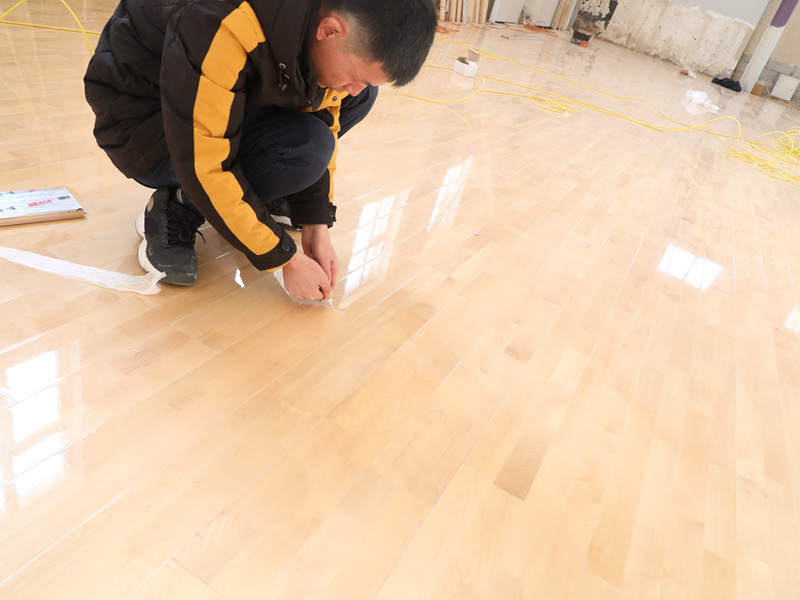
2025-05-19 15:27 Clicks:115
Before diving into the step-by-step details, here’s a concise overview of how professional crews paint basketball courts: First, the existing surface (wood or concrete/asphalt) is thoroughly cleaned, repaired, and primed. Next, high-performance acrylic court coatings—often fortified with silica sand for grip—are rolled on in multiple base coats. Court lines and logos are then applied using precise taping, stencils (sometimes computer-cut), and specialty brushes or rollers. Complex graphics may require layered vinyl stencils, airbrushing, and hand-cut transfer paper to achieve sharp edges and metallic effects. Finally, a clear sealer or finish coat is applied to lock in color, add non-skid texture, and protect against wear and weather. Maintenance typically involves periodic touch-ups, cleaning, and recoat cycles to keep the court looking and playing its best.

Professional basketball courts use different substrate treatments depending on the surface:
Concrete/Asphalt (outdoor): Courts are coated with fortified acrylic paint specifically formulated for sports surfaces. These acrylic coatings are enhanced with graded silica sands to improve traction and durability against UV, moisture, and temperature changes.
Maple Hardwood (indoor): While the wood itself is typically unfinished or sealed with a clear coat, the court lines and logos are painted onto the finished hardwood using acrylic or specialized floor paints that adhere without compromising the wood’s resilience.
Proper prep is critical for paint adhesion and longevity:
Thorough Cleaning: Remove dirt, grease, old coatings, and mildew via pressure-washing (outdoor) or dust-mopping and light sanding (indoor) to expose a fresh surface.
Repairs: Fill any cracks, divots, or gaps in concrete using patching compounds; sand and fill wood gaps or replace damaged boards as needed.
Priming: Apply a high-quality acrylic primer to promote adhesion and seal porous areas. Outdoor primers dry to the touch in 2–4 hours under standard conditions.
Once primed, the base color coats are applied:
Roller Application: Use 9″ rollers with extension poles for large areas; smaller rollers (4″ or 1½″) may be used around edges or obstacles.
Coat Build-Up: Typically 2–3 coats of acrylic court paint are rolled on, allowing proper drying time between layers to achieve uniform opacity and durability.
Court lines (boundary, free-throw, three-point) are applied with precision:
Layout and Tape: Lines are measured with tape measures, chalk or pencil marks, and string lines for straight runs. High-quality sports masking tape defines the edges.
Paint Application: Use narrow rollers or brushes to fill in taped areas. After the paint dries, the tape is peeled back to reveal crisp lines.
Custom logos require additional steps:
Digital Design & Stenciling: Graphics are created in vector software (e.g., Adobe Illustrator) and transferred to a plotter to cut layered vinyl stencils.
Layered Painting: Base colors are painted first; once dry, successive stencil layers add gradients, textures, and metallic effects. Intricate designs may use transfer paper and airbrushing to ensure even metallic sheen without brush-stroke variations.
Hand Touch-Ups: Artists may hand-cut small sections and paint details by brush to correct imperfections, sanding and repainting areas until perfect .
To protect the court and extend its lifespan:
Sealer Application: A clear acrylic sealer or finish coat is rolled on, often with a non-skid additive mixed in to retain grip characteristics.
Curing and Drying: Courts generally need at least 24–48 hours of dry time before use, depending on weather and humidity.
Routine Maintenance: Regular cleaning and annual or biennial touch-ups of high-traffic lines/logos keep the court looking fresh; full recoats may be scheduled every 3–5 years for outdoor courts and 7–10 years for indoor surfaces .
By following these meticulous preparation, painting, and finishing steps—using quality materials, precise layout techniques, and skilled craftsmanship—professionals deliver courts that are both visually striking and performance-ready.